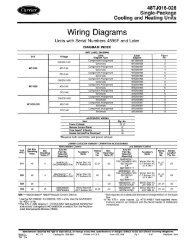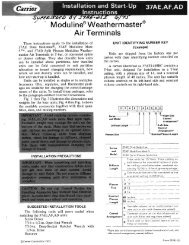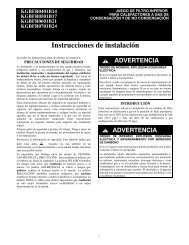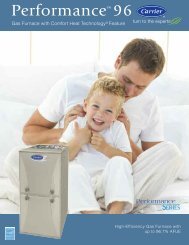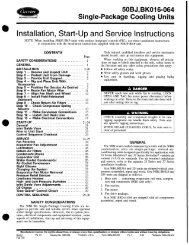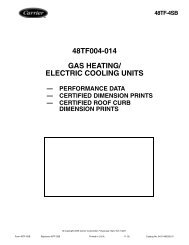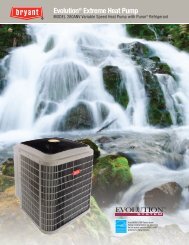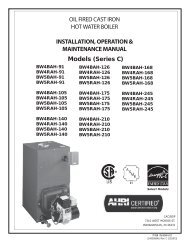Start-Up, Operation, and Maintenance Instructions
Start-Up, Operation, and Maintenance Instructions
Start-Up, Operation, and Maintenance Instructions
You also want an ePaper? Increase the reach of your titles
YUMPU automatically turns print PDFs into web optimized ePapers that Google loves.
Owner-Modified CCN Tables — The following EQUIP-<br />
MENT CONFIGURATION screens are described for reference<br />
only.<br />
OCCDEFCS — The OCCDEFCS screen contains the Local<br />
<strong>and</strong> CCN time schedules, which can be modified here or on the<br />
SCHEDULE screen as described previously.<br />
HOLIDAYS — From the HOLIDAYS screen, the days of the<br />
year that holidays are in effect can be configured. See the holiday<br />
paragraphs in the Controls section for more details.<br />
BRODEF — The BRODEF screen defines the start <strong>and</strong> end of<br />
daylight savings time. Enter the dates for the start <strong>and</strong> end of<br />
daylight savings if required for your location. BRODEF also<br />
activates the Broadcast function which enables the holiday<br />
periods that are defined on the CVC/ICVC to take effect.<br />
Other Tables — The CONSUME, NET_OPT, <strong>and</strong> RUN-<br />
TIME screens contain parameters used with a CCN system.<br />
See the applicable CCN manual for more information on these<br />
screens. These tables can only be defined from a CCN Building<br />
Supervisor.<br />
Perform a Control Test — Check the safety controls<br />
status by performing an automated control test. Access the<br />
CONTROL TEST table <strong>and</strong> select a test to be performed function<br />
(Table 9).<br />
The Automated Control Test checks all outputs <strong>and</strong> inputs<br />
for function. In order to successfully proceed with the controls<br />
test, the compressor should be off, no alarms showing, <strong>and</strong> voltage<br />
should be within ±10% of rating plate value. The compressor<br />
can be put in OFF mode by pressing the STOP push-button<br />
on the CVC/ICVC. Each test asks the operator to confirm the<br />
operation is occurring <strong>and</strong> whether or not to continue. If an error<br />
occurs, the operator can try to address the problem as the<br />
test is being done or note the problem <strong>and</strong> proceed to the next<br />
test.<br />
NOTE: Enter guide vane calibration to calibrate guide<br />
input on CCM (Plug J4 upper terminal 9 <strong>and</strong> 10).<br />
NOTE: If during the control test the guide vanes do not open,<br />
verify the low pressure alarm is not active. (An active low<br />
pressure alarm causes the guide vanes to close.)<br />
NOTE: The oil pump test will not energize the oil pump if<br />
cooler pressure is below –5 psig (–35 kPa).<br />
When the control test is finished or the EXIT softkey is<br />
pressed, the test stops, <strong>and</strong> the CONTROL TEST menu displays.<br />
If a specific automated test procedure is not completed,<br />
access the particular control test to test the function when ready.<br />
The CONTROL TEST menu is described in the table below.<br />
CCM Temperature Thermistors Check of all thermistors.<br />
CCM Pressure Transducers Check of all transducers.<br />
Checks operation of pump outputs;<br />
Pump<br />
pumps are activated. Also tests associated<br />
inputs such as flow or pressure.<br />
Discrete outputs<br />
Activation of all on/off outputs individually.<br />
Guide Vane Check of the guide vane operation.<br />
Diffuser Actuator* Check of the diffuser actuator.<br />
Pumpdown prevents the low refrigerant<br />
alarm during evacuation so refrigerant<br />
Pumpdown/Lockout<br />
can be removed form the unit. Also locks<br />
the compressor off <strong>and</strong> starts the water<br />
pumps.<br />
Terminate Lockout<br />
To charge refrigerant <strong>and</strong> enable the<br />
chiller to run after pumpdown lockout.<br />
Guide Vane Calibration Calibrates guide vane input on CCM.<br />
*Diffuser tests function only on size 4 <strong>and</strong> 5 compressor with diffuser control<br />
enabled.<br />
NOTE: During any of the tests, an out-of-range reading will have an asterisk<br />
(*) next to the reading <strong>and</strong> a message will be displayed if you have diffuser<br />
control enabled.<br />
62<br />
COOLER CONDENSER PRESSURE TRANSDUCER<br />
AND WATERSIDE FLOW DEVICE CALIBRATION<br />
(Optional with ICVC inputs available) — Calibration can be<br />
checked by comparing the pressure readings from the<br />
transducer to an accurate refrigeration gage reading. These<br />
readings can be viewed or calibrated from the HEAT_EX<br />
screen on the CVC/ICVC. The transducer can be checked <strong>and</strong><br />
calibrated at 2 pressure points. These calibration points are<br />
0 psig (0 kPa) <strong>and</strong> between 25 <strong>and</strong> 250 psig (173 <strong>and</strong><br />
1724 kPa). To calibrate these transducers:<br />
1. Shut down the compressor, cooler, <strong>and</strong> condenser pumps.<br />
NOTE: There should be no flow through the heat<br />
exchangers.<br />
2. Disconnect the transducer in question from its Schrader<br />
fitting for cooler or condenser transducer calibration. For<br />
oil pressure or flow device calibration keep transducer in<br />
place.<br />
NOTE: If the cooler or condenser vessels are at 0 psig<br />
(0 kPa) or are open to atmospheric pressure, the transducers<br />
can be calibrated for zero without removing the transducer<br />
from the vessel.<br />
3. Access the HEAT_EX screen <strong>and</strong> view the particular<br />
transducer reading (the EVAPORATOR PRESSURE or<br />
CONDENSER PRESSURE parameter on the HEAT_EX<br />
screen). To calibrate oil pressure or waterside flow device,<br />
view the particular reading (CHILLED WATER<br />
DELTA P <strong>and</strong> CONDENSER WATER DELTA P on the<br />
HEAT_EX screen <strong>and</strong> OIL PUMP DELTA P on the<br />
COMPRESS screen). It should read 0 psi (0 kPa). If the<br />
reading is not 0 psi (0 kPa), but within ±5 psi (35 kPa),<br />
the value may be set to zero by pressing the SELECT<br />
softkey while the appropriate transducer parameter is<br />
highlighted on the CVC/ICVC screen. Then press the<br />
ENTER softkey. The value will now go to zero. No high<br />
end calibration is necessary for OIL PUMP DELTA P or<br />
flow devices.<br />
If the transducer value is not within the calibration range,<br />
the transducer returns to the original reading. If the pressure<br />
is within the allowed range (noted above), check the<br />
voltage ratio of the transducer. To obtain the voltage ratio,<br />
divide the voltage (dc) input from the transducer by the<br />
supply voltage signal (displayed in CONTROL TEST<br />
menu in the CCM PRESSURE TRANSDUCERS<br />
screen) or measure across the positive (+ red) <strong>and</strong> negative<br />
(– black) leads of the transducer. For example, the<br />
condenser transducer voltage input is measured at CCM<br />
terminals J2-4 <strong>and</strong> J2-5. The voltage ratio must be between<br />
0.80 <strong>and</strong> 0.11 for the software to allow calibration.<br />
Rotate the waterside flow pressure device from the inlet<br />
nozzle to the outlet nozzle <strong>and</strong> repeat this step. If rotating<br />
the waterside flow device does not allow calibration then<br />
pressurize the transducer until the ratio is within range.<br />
Then attempt calibration again.<br />
4. A high pressure point can also be calibrated between 25<br />
<strong>and</strong> 250 psig (172.4 <strong>and</strong> 1723.7 kPa) by attaching a regulated<br />
250 psig (1724 kPa) pressure (usually from a nitrogen<br />
cylinder). The high pressure point can be calibrated<br />
by accessing the appropriate transducer parameter on the<br />
HEAT_EX screen, highlighting the parameter, pressing<br />
the SELECT softkey, <strong>and</strong> then using the INCREASE<br />
or DECREASE softkeys to adjust the value to the exact<br />
pressure on the refrigerant gage. Press the ENTER<br />
softkey<br />
to finish the calibration. Pressures at high altitude locations<br />
must be compensated for, so the chiller temperature/pressure<br />
relationship is correct.<br />
The PIC II does not allow calibration if the transducer is too<br />
far out of calibration. In this case, a new transducer must be<br />
installed <strong>and</strong> recalibrated.







